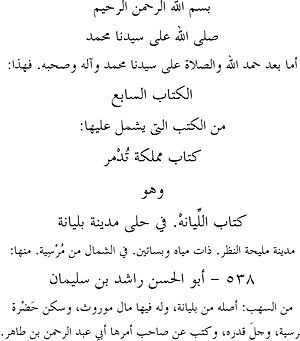Ibn Sa'id al-Maghribi facts for kids

Abū al-Ḥasan ʿAlī ibn Mūsā ibn Saʿīd al-Maghribī (Arabic: علي بن موسى المغربي بن سعيد) (1213–1286), also known as Ibn Saʿīd al-Andalusī, was a famous Arab scholar. He was a geographer, historian, and poet. He is best known for collecting many poems from al-Andalus (parts of Spain and Portugal ruled by Muslims) during the 12th and 13th centuries.
Contents
Life Story of Ibn Said
Ibn Said was born in 1213 in Alcalá la Real, a town near Granada. His family was very important and had many writers and scholars. They were related to Ammar ibn Yasir, a close friend of the Prophet Muhammad.
Ibn Said grew up in Marrakesh. He later studied in Seville. He traveled a lot, visiting cities like Tunis, Alexandria, Cairo, Jerusalem, and Aleppo. When he was 30, he went on a pilgrimage to Mecca, a holy journey for Muslims.
He was also a good friend of a poet named Ibn Mokond Al-Lishboni, who was from Lisbon. Ibn Said spent his last years in Tunis, where he passed away in 1286.
Ibn Said's Writings and Books
Ibn Said al-Maghribi wrote or helped create at least 40 books. These books covered many different topics.
The Extraordinary Book on the West
His most famous work is a huge 15-volume book called al-Mughrib fī ḥulā l-Maghrib. This title means 'The Extraordinary Book on the Adornments of the West'. This book was a family project that started more than a century before Ibn Said was born!
His great-grandfather, ‘Abd al-Malik, asked Abū Muḥammad al-Ḥijārī to start it. Abū Muḥammad al-Ḥijārī wrote 6 volumes. Then, Ibn Said's great-grandfather, grandfather, great-uncle, and father all added to it. Finally, Ibn Said finished the entire collection.
This book is like a mix of poetry and geography. It gathers information about poets from the Maghreb region (North Africa) and organizes it by where they came from.
Banners of the Champions
A part of the Mughrib became a separate book called Rāyāt al-mubarrizīn wa-ghāyāt al-mumayyazīn. This means 'Banners of the Champions and the Standards of the Distinguished'. Ibn Said put this collection together in Cairo. He finished it on June 21, 1243.
Many people think this is one of the most important collections of poetry from al-Andalus. Ibn Said wanted to show that poetry from the West was just as good as poetry from the East. He also made sure to include many poems by himself and his family!
His Interest in Geography
Because he traveled so much, Ibn Said was very interested in geography. In 1250, he wrote a book called Kitab bast al- ard fi 't -t ul wa-'l-'ard. This book was about the Earth's longitudes and latitudes.
His book Kitab al-Jughrafiya (Geography) shares his experiences from his many travels. He explored the Muslim world and the coasts of the Indian Ocean. He even wrote about parts of northern Europe, like Ireland and Iceland. He also visited Armenia and spent time at the court of Hulagu Khan between 1256 and 1265.
Ibn Said's Poetry Example
Ibn Said also wrote his own poems. He included some of them in his book Rāyāt al-mubarrizīn wa-ghāyāt al-mumayyazīn. Here is an example of one of his poems, translated into English:
Black hindquarters, white chest:
he flies on the wings of the wind.
When you look at him you see dark night
opening, giving way to dawn.
Sons of Shem and Ham live harmoniously
in him, and take no care for the words
of would-be troublemakers.
Men's eyes light up when they see
reflected in his beauty
the clear strong black and white
of the eyes of beautiful women.
See also
 In Spanish: Ibn Said al-Maghribi para niños
In Spanish: Ibn Said al-Maghribi para niños

